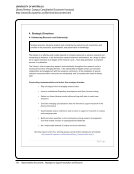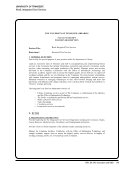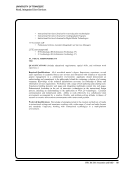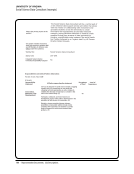108 · Representative Documents: Strategies to Support Innovation and Research
NORTHWESTERN UNIVERSITY
Strategic Plan, FY 2012–14 (excerpts)
https://www.library.northwestern.edu/sites/www.library.northwestern.edu/files/pdfs/NULStratPlan2012.pdf
UNIVERSITY LIBRARY STRATEGIC PLAN, FY2012-14 3
The University Library is more than a collection of books, although it has many and we are the
curators. More importantly to this strategic plan, we are a society of scholars and a community
whose goal is to support the creation, access, dissemination, and preservation of knowledge and
we communicate and teach how to access that knowledge to local and national communities, and
throughout the world. (A profile of the Library is in Appendix A.)
We collect information essential for the Northwestern community to investigate intellectual,
scientific and creative questions and we assure, through large scale national collaboration, new
technology development and curated preservation, that students and faculty have access to the
texts they require, whether rare artifact or born digital. We maintain resources valued throughout
the world for their scope and integrity and we find ways to allow the world to see these materials
through new digital communication formats. We teach research strategies to Northwestern
students, explore evolving scholarly communication models with faculty, and interpret
collections for the general community. As an institution, “the Library,” the designated physical
spaces we oversee, provides an academic crossroads for students and faculty who need study
space, collaboration space, technical support and distinctive collections.
Library-specific themes:
The work of the Library community can help enable all of the University’s goals. We also need,
however, to articulate strategic and targeted objectives pertinent to our professional domain and
current challenges. Five themes unique to the Library’s mission have been identified. Each
theme, when considered in the context of each University goal, reveals specific directions and
activities that then promote convergence between the library and our parent institution.
Following is a brief description of each of the cross-cutting themes and how it frames university
goals.
A. Distinctive Collections: The digital transformation of all aspects of the scholarly publishing
process challenges the library to ensure that needed research materials in all forms and formats
are readily available to scholars even while new venues of acquisition, methods of preservation,
and access methodologies are in rapid development. At the same time, major research libraries
contribute to the world’s cultural heritage by building collections of distinctive primary
resources. We will craft mechanisms to ensure that digital and print information from all sources
--owned, leased, open access, locally created and consortially acquired --is integrated to present
one coherent corpus. We will investigate new methods of preservation for locally and nationally
created digital and print resources to which we seek enduring scholarly access. And we will
balance three collection components – the provision of leading edge resources for emerging
research directions, the sustained growth of core academic collections, and the enhancement of
unique scholarly collections of worldwide significance.
The library will integrate information resources to effect a unified, curated and comprehensive
array of local and remote materials that are easily accessed, responsibly preserved and vigorously
promoted to faculty, students, staff and broader user communities, in support of Northwestern’s
learning, teaching, and research agendas.
NORTHWESTERN UNIVERSITY
Strategic Plan, FY 2012–14 (excerpts)
https://www.library.northwestern.edu/sites/www.library.northwestern.edu/files/pdfs/NULStratPlan2012.pdf
UNIVERSITY LIBRARY STRATEGIC PLAN, FY2012-14 3
The University Library is more than a collection of books, although it has many and we are the
curators. More importantly to this strategic plan, we are a society of scholars and a community
whose goal is to support the creation, access, dissemination, and preservation of knowledge and
we communicate and teach how to access that knowledge to local and national communities, and
throughout the world. (A profile of the Library is in Appendix A.)
We collect information essential for the Northwestern community to investigate intellectual,
scientific and creative questions and we assure, through large scale national collaboration, new
technology development and curated preservation, that students and faculty have access to the
texts they require, whether rare artifact or born digital. We maintain resources valued throughout
the world for their scope and integrity and we find ways to allow the world to see these materials
through new digital communication formats. We teach research strategies to Northwestern
students, explore evolving scholarly communication models with faculty, and interpret
collections for the general community. As an institution, “the Library,” the designated physical
spaces we oversee, provides an academic crossroads for students and faculty who need study
space, collaboration space, technical support and distinctive collections.
Library-specific themes:
The work of the Library community can help enable all of the University’s goals. We also need,
however, to articulate strategic and targeted objectives pertinent to our professional domain and
current challenges. Five themes unique to the Library’s mission have been identified. Each
theme, when considered in the context of each University goal, reveals specific directions and
activities that then promote convergence between the library and our parent institution.
Following is a brief description of each of the cross-cutting themes and how it frames university
goals.
A. Distinctive Collections: The digital transformation of all aspects of the scholarly publishing
process challenges the library to ensure that needed research materials in all forms and formats
are readily available to scholars even while new venues of acquisition, methods of preservation,
and access methodologies are in rapid development. At the same time, major research libraries
contribute to the world’s cultural heritage by building collections of distinctive primary
resources. We will craft mechanisms to ensure that digital and print information from all sources
--owned, leased, open access, locally created and consortially acquired --is integrated to present
one coherent corpus. We will investigate new methods of preservation for locally and nationally
created digital and print resources to which we seek enduring scholarly access. And we will
balance three collection components – the provision of leading edge resources for emerging
research directions, the sustained growth of core academic collections, and the enhancement of
unique scholarly collections of worldwide significance.
The library will integrate information resources to effect a unified, curated and comprehensive
array of local and remote materials that are easily accessed, responsibly preserved and vigorously
promoted to faculty, students, staff and broader user communities, in support of Northwestern’s
learning, teaching, and research agendas.
































































































































































































